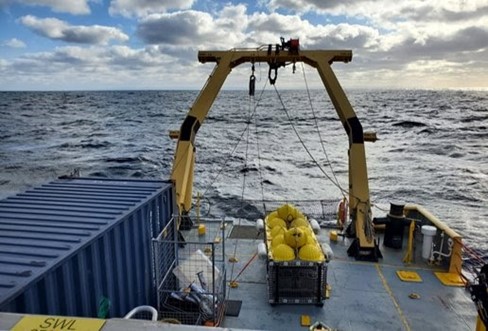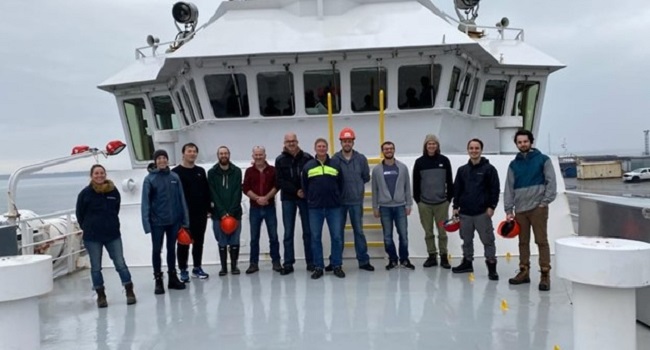News
» Go to news mainCruise Report: TReX Deep 1 Mission

October 22 - 29, 2021
First Leg - Rimouski to Sydney
Second Leg - Sydney to Rimouski
The Tracer Release Experiment (TReX) Deep 1 Mission was carried out onboard the RV Coriolis II, circumventing the Gulf of St. Lawrence from the 22nd to the 29th of October 2021. It marked the beginning of the TReX Deep Experiment in the Gulf of St. Lawrence, an ambitious project co-funded by MEOPAR and the Réseau Québec Maritime (RQM). The mission had two main goals that were successfully completed: 1) To inject the trifluoromethyl sulphur pentafluoride tracer into the deep waters of the Gulf of St. Lawrence using the Ocean Tracer Injection System (OTIS) and 2) To extensively sample the Gulf of St. Lawrence to create a rigorous chemical data set with a wide geographical range at the time of injection.

View from the stern of RV coriolis
The Crew
Dr. Toste Tanhua from GEOMAR acted as Chief Scientist for the first leg of the cruise from Rimouski, Quebec to Sydney, Nova Scotia (October 22nd - 26th). He led a team composed of two engineers from GEOMAR (Rene Witt and Mario Muller), two scientists from ISMER (Zhaozhao Li and Olivier Herard), and three scientists from Dalhousie (Jonathan Coyne, Marie Babineau, and William Nesbitt). Upon reaching Sydney, NS after an extremely successful first leg, Dr. Tanhua along with Rene and Mario departed the Coriolis II to enjoy a couple days on Cape Breton Island before flying home to Germany. Dr. Douglas Wallace replaced Dr. Tanhua as Chief Scientist upon his departure, boarding the Coriolis II on October 26th with two CERC.OCEAN students (Adriana Reitano and Sara Wong). The whole cruise were supported by two incredible CTD technicians (Christian Boutot and Gilles Desmeules) and the excellent crew from REFORMAR. Rather uniquely, besides the two Chief Scientists, the scientific team was composed completely of undergraduate and graduate students.

Group photo of the team onboard for the TReX Deep 1 mission
From left to right: Gwenaëlle Chaillou, Marie Babineau, Zhaozhao Li, Olivier Herard, Gilles Desmeules, Mario Muller, Toste Tanhua, Rene Witt, Ludovic Pascal, Christian Boutot, William Nesbitt, and Johnathan Coyne
The Work at Sea
On our voyage, onboard analysis for spectrophotometric pH and dissolved oxygen (Winkler titrations) were performed by Olivier. These were the only onboard analyses conducted during the TReX Deep 1 mission. Dissolved oxygen measurements were performed until a calibration curve could be constructed to confirm the value given from the probe. Measurements of pH were taken at every sampled depth, leading to a total of 141 measurements. During the first leg, the tracer was successfully injected into the deep waters just inside the Cabot Strait. The deployment was difficult as there were large waves and the OTIS had not been deployed in this manner before. It took two attempts to successfully deploy the OTIS as the first time it was put in the water it was too buoyant to reach the targeted density surface.

Samples from the TReX Deep 1 mission
CTD rosette operated around the clock. The TReX team visited a total of 32 stations and sampled at a total of 141 depths over a period of just 8 days! We brought back an impressive number of samples totaling 1173! These samples were collected for the following analyses:
- Dissolved Inorganic Carbon- δ13C (DIC-13C)
- Total Alkalinity
- Nutrients
- Dissolved Organic Carbon
- Oxygen-18 (O18)
- Inorganic Iodine
- Iodine-129 (I129)
Overall, TReX Deep 1 was an extremely successful mission. We look forward to TReX Deep 2 and hope for similar good circumstances for the upcoming cruise.
CLICK HERE to learn more about MEOPAR-RQM TReX project!
Recent News
- Recap of ASITA 2024 Conference
- ASITA 2024 Conference
- Happy World Ocean Day! + CMOS congress 2023 recap
- Upcoming presentations by CERC.OCEAN lab at the CMOS 57th congress
- UPDATED: List of Instrumentation and Analytical Services
- Field Report: Exploratory Study of nitrogen cycling at the Lagoon Lagos
- Marine Robots – Back in Action at OHMSETT
- Spotlight of the month: Adriana Reitano

